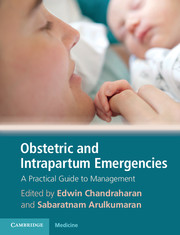Crossref Citations
This Book has been
cited by the following publications. This list is generated based on data provided by Crossref.
Pereira, Susana
and
Chandraharan, Edwin
2018.
Medicolegal Issues in Obstetrics and Gynaecology.
p.
115.
Oshvandi, Khodayar
Masoumi, Seyedeh Zahra
Kazemi, Farideh
and
Shayan, Arezoo
2020.
Comparison of Maternal Anemia and Their Infant Apgar Scores in Conventional Vaginal Delivery with Physiological Delivery.
Avicenna Journal of Nursing and Midwifery Care,
Vol. 28,
Issue. 4,
p.
9.
Escobar, Maria Fernanda
Nassar, Anwar H.
Theron, Gerhard
Barnea, Eythan R.
Nicholson, Wanda
Ramasauskaite, Diana
Lloyd, Isabel
Chandraharan, Edwin
Miller, Suellen
Burke, Thomas
Ossanan, Gabriel
Andres Carvajal, Javier
Ramos, Isabella
Hincapie, Maria Antonia
Loaiza, Sara
and
Nasner, Daniela
2022.
FIGO recommendations on the management of postpartum hemorrhage 2022.
International Journal of Gynecology & Obstetrics,
Vol. 157,
Issue. S1,
p.
3.
TELLİ, Elçin
2023.
Postpartum Kanama.
OSMANGAZİ JOURNAL OF MEDICINE,
SELVARAJU, VINOTHINI
KARTHICK, P. A.
and
SWAMINATHAN, RAMAKRISHNAN
2023.
DETECTION OF PRETERM BIRTH FROM THE NONCONTRACTION SEGMENTS OF UTERINE EMG USING HJORTH PARAMETERS AND SUPPORT VECTOR MACHINE.
Journal of Mechanics in Medicine and Biology,
Vol. 23,
Issue. 06,
Yarrington, Aimee
2024.
Cord prolapse.
Journal of Paramedic Practice,
Vol. 16,
Issue. 11,
p.
1.



